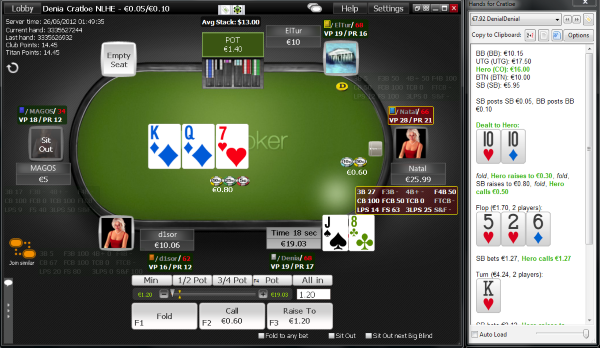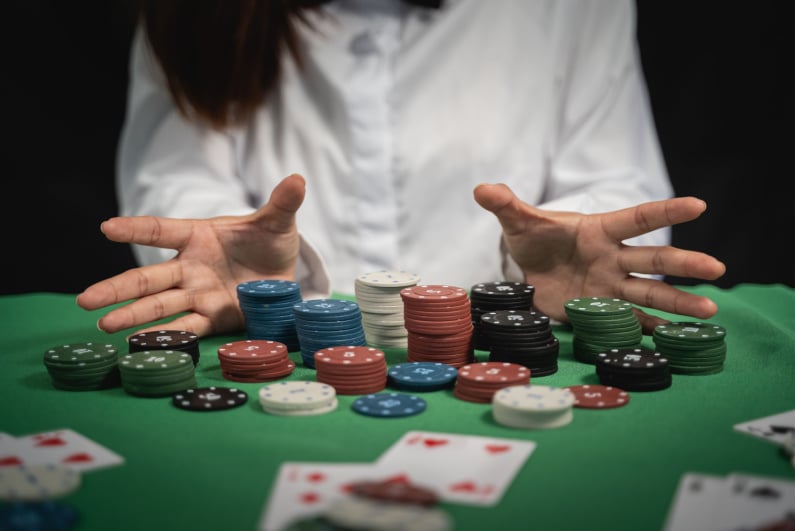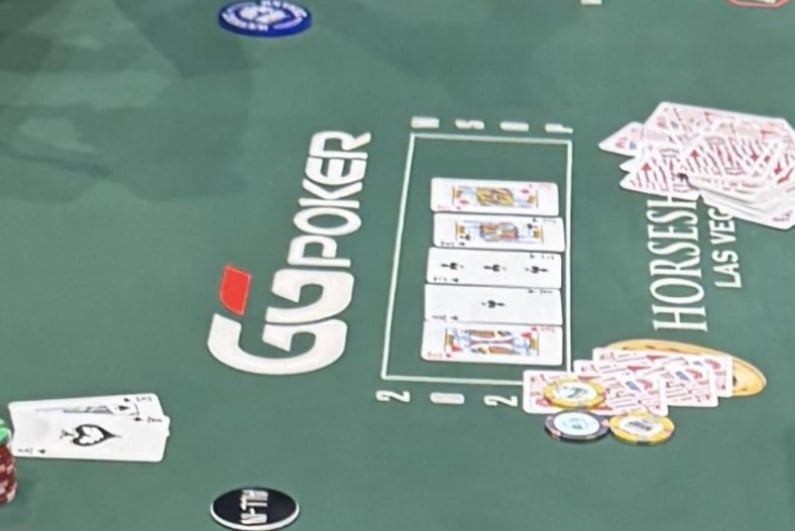Studying versus training
One of the most frequent questions I’m asked is how to get better at poker and what approach and tools I use to study. Most online players with aspirations to become or stay winning players realize they need to study or train. There is a difference between those words, study and train, but I think poker players often conflate the two, or do one without realizing the other is important too.
the goal of training is to practice and reinforce what you already know
On a recent episode of their excellent podcast ‘Poker On The Mind,’ Gareth James and Tricia Cardner talked expertly on the importance of and differences between both. The objective of study is to learn something new, while the goal of training is to practice and reinforce what you already know (or think you do). I think of it as analogous to my days as a competitive runner. Some workouts were designed to push me up to or past my limits (speed training, races, long runs) so as to raise them. Others were designed to simply maintain my fitness or recover from a limit pushing workout the previous day (easy recovery runs) so as not to overtrain and risk injury or burnout.
Admittedly, in poker the lines are a bit more blurred. Often when we are studying we are reinforcing ranges and spots we already know while looking for new concepts or strategic nuances. If I’m studying check raising ranges button versus blind, I’m reinforcing what the opening ranges are, and the cbetting ranges, while I examine the check raising ranges. If I’m training a spot with DTO and make a large error, I’m going to drill down and look at the ranges and spot in detail to try to discover what I’m missing or misunderstanding.
Nevertheless, I think it is still useful to distinguish between the two, and in this article I’m gong to look at the best tools for both.
Study
Here are the study tools I currently use in order of how much I use them myself and recommend them to my students:
1) GTOWizard
This is a one stop shop for preflop ranges (both normal and ICM) and post-flop solves of thousands of different spots. It’s constantly being added to and comes with its own trainer.
it’s come on in leaps and bounds and is now the main tool I recommend
Barry Carter and I made a number of videos on it, and I particularly recommend the one covering the powerful Aggregate Reports feature. I wasn’t that impressed with this tool when I first saw it over a year ago and used the more expensive Odin instead. However, it’s come on in leaps and bounds and is now the main tool I recommend to students (and use myself).
2) Holdem Resources Calculator
Perfect for analyzing preflop spots particularly when ICM and/or bounties are a factor. You can enter any stack sizes, payouts, etc. and it does the rest to answer the question: “what hands should I play/shove/call a shove with in this specific spot?”
ICMiser has the same functionality and is also very good, I’m reliably informed (I’ve only ever used HRC and go on doing so primarily because of habit/familiarity). HRC beta is a major advance on the original as it factors in post flop equity realization.
3) PokerSnowie
An AI tool rather than a solver, PokerSnowie has suffered a little from the scoffs of GTO snobs that “it’s not GTO” (strictly speaking, neither are any of the other solvers perfect GTO). It also means it’s gotten stronger and closer to GTO over time, and it can give you a reasonable answer to any poker spot, no matter how weird or multi-way. It also has a very useful mass import function which can be used to quickly identify leaks in your game. It also has its own trainer function.

This list is aimed at the type of person who has an hour or two to devote to study, but if you only have a few minutes a day I’d move this one to the top of the list. Don’t let perfect be the enemy of good, as the old Italian proverb says.
4) PIOSolver
If I was writing this list even a year ago this would have been on top. I still love PIO. It remains the gold standard when it comes to running your own solves but the reality is with the newer tools out there there’s a lot less reason to do this. What takes 20 minutes to set up and a few hours to run in PIO can often be located in a few seconds in something like GTOWizard. If you want to delve deeper and run your own node locked solves though you still need PIO. Or if you think you’re up against very different ranges from GTO ones.
5) PokerTracker
If I was writing this a decade ago this would have not only been top of the list, it might have been the entire list. Back then most of my edge came from being able to quickly analyze statistical data in real time to identify likely leaks specific opponents had, and work out how best to exploit them. That was online poker back then: most of the weaker players had massive egregious leaks that could be quickly identified if you watched them for a while, or with the help of PokerTracker or other HUDs if you were playing too many tables to pay attention to specific opponents.

Since then a couple of things happened. Firstly, a misguided belief that HUDs were cheating took hold in enough recreational minds that sites started to ban them. In reality, the only thing they did was allow pros to play more tables simultaneously, which believe it or not was actually a good thing not just for the sites collecting rake on each one but also for recreationals. It meant they were competing against pros only able to give their table 1/24th of their attention (or whatever number of tables they were playing). The disappearance of the HUDs (or more precisely them being driven underground) on most sites had some unintended consequences. Not only did it reduce the number of tables pros could play simultaneously (with a knock on effect on prize pools and the overall online ecosystem, something the industry tried to compensate for by allowing reentries, another thing which is way worse for the recreational bottom line and deposit lifecycle than HUDs ever were) but it accelerated the drive to GTO and solver learning.
you just don’t see as many total outlier playing styles any more
Recreationals with egregious leaks lost their money faster than ever unless they hit the lab themselves. Those that did stuck around, those that didn’t drifted away, and overall standards rose to where they are now. Of course the better players still have an edge over the weaker ones, but there’s been a general convergence in playing styles and you just don’t see as many total outlier playing styles any more. These days the talk of the town is less specific opponent tendencies and exploits and more “population reads.”
All that said, HUDs have not disappeared completely. Some sites like Stars and ACR still allow them, and even if they are less useful as playing aids these days because of the ecosystem changes outlined above, they can play a vital role in the general game improvement drive we are all on. These days they’re used more to try to identify and fix our own leaks than to exploit specific opponents, and also to help identify population tendencies.
6) Training sites
About 12 years ago, the first training sites were a leap forward and game changer. They allowed access to elite level strategy for the masses (or at least those who were willing to stump up for a subscription) for the first time. The initial sites were pretty much just fonts of passive learning: you watched a video and took from it what you could. The more by the numbers training sites these days stick to the same formula, but in my opinion the two best sites, JakaCoaching and LearnProPoker, go beyond that. In the interests of full disclosure I have produced work for both so could be accused of bias, but in actual fact I genuinely believe both sites offer more than the ‘watch a video and learn from it what you will’ paradigm and that’s a big part of the reason I chose to work with both.
Faraz Jaka of JakaCoaching and I share a belief that most people don’t learn much simply from being shown solver outputs even if they’re well explained. Most people benefit more from clearly explained concepts and clearly identified heuristics. Also, most of the content on the site is webinars where students can attend and ask questions in running, making it a more interactive learning experience and less passive viewing experience.
Both Ryan Laplante at LearnProPoker and I share a view that good educational fundamentals like structured courses broken down in to short digestible chunks that don’t exceed the attention span of most viewers work better than two-hour-long videos on whatever the instructor felt like talking about.
Books and videos
Given that I’ve written four of the damned things it might strike you as odd I have books so far down the list, and I’m lumping it in with videos which I’ve already cast shade at in number six above. We all have different learning styles and methods. As much as I love books and benefit from them myself, I have to concede most students don’t get as much from them as I do. I’d also have to concede there are far more bad poker books out there than good ones. The ones (other than my own) I do recommend are Modern Poker Theory by Michael Acevedo, and both Play Optimal Poker books by Andrew Brokos.
I’ve already said I don’t rate videos that high as learning tools as they’re not focused enough and can end up nearer to passive entertainment than active learning. That said, there are some good ones out there if you search for them on YouTube, including (I hope) the ones I made for Barry Carter’s channel, and Cardschat.
Training
This is going to be a much shorter section than the one on studying, not because I think it’s less important, but just because there’s really only one tool I strongly recommend, and that’s DTO. The original and still GOAT training app, DTO is perfect for drilling yourself in any spot that gives you trouble on your phone, iPad or computer when you have a few minutes to spare. If you want to purchase, go to https://www.dto.poker and use code CHIPRACE for 20% off.
DTO does everything the others do either better or easier
Several of the study tools like GTOWizard, PIO, and PokerSnowie also have their own trainer function, but the only one I recommend is PokerSnowie. DTO does everything the others do either better or easier, but PokerSnowie scratches one itch none of the others do: multi-way spots.
The balance
Achieving the right balance between playing, studying and training is very personal. Some people do most of their training by actually playing, and it works for them. Others just condemn themselves to keep repeating the same mistakes if they take that approach. Some with exceptional pattern recognition are good enough at identifying heuristics and concepts for themselves that they have little need for study beyond the training they do. For some others, studying is a lot sexier and more fun than routine training, but their bottom line would benefit much more from drilling themselves in the most common spots rather than looking for weird triple check raise lines in their solver study. It’s very much up to you to decide which type you are.
Finally, in the same way runners alternate hard and easy workouts to avoid overtraining, it’s worth putting some thought into when to study and when to train. In my experience, training is best done in short bursts (so it doesn’t become too boring) when you have a little spare time. It’s far better to train ten minutes a day six days a week than one hour once a week. I also think training works best just before you play, whereas study is best left until after your session, or better yet, your days off. Study sessions should be longer than ten-minute training sessions, which is another reason you don’t want to tire yourself out doing one before you play.




